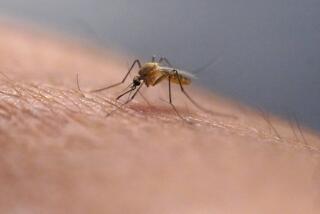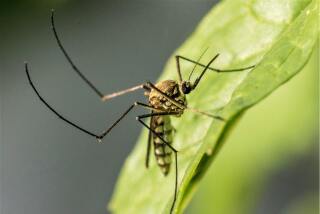Preparation for Virus Paying Off
As California enters a critical period in its battle against West Nile virus, health experts said the state holds several advantages that could help prevent the mass epidemic that has swept other states.
The biggest test will come over the next two months, the peak season for mosquitoes, which spread the virus to humans. In other states hit hard by West Nile, the vast majority of human infections and deaths occurred in August and September, with the virus tapering off by winter.
Although California health officials are bracing for more cases this summer, they said the infection pattern so far gives them cause for guarded optimism.
To date, 42 Californians are confirmed to have contracted West Nile and one person has died. That is more cases than three other states hit hard by the virus -- Colorado, Nebraska and South Dakota -- recorded during the same period last year. But those states have much smaller populations. And health officials said it’s remarkable that California hasn’t seen far more cases, given that the virus has spread in densely populated areas.
One advantage California has is its dry climate.
West Nile was able to expand rapidly in rural areas of other states because of the many marshlands and lakes where mosquitoes breed, health officials said. West Nile first hit California in suburban areas of Riverside, San Bernardino and Los Angeles counties, which have relatively few marshes or other natural breeding areas. Though the virus is spreading through more urban areas in California than in other states, the lack of standing water is helping to limit reproduction of the virus-carrying mosquitoes.
Other states also lacked well-organized mosquito-abatement programs and didn’t begin mass larvicide spraying until after the virus was established, health officials said. By contrast, California has one of the nation’s most elaborate networks of vector control districts, and officials have been spraying for years in anticipation of West Nile.
“We are doing good compared to other states,” said Stephanie Miladin, spokeswoman for the Greater Los Angeles County Vector Control District. “There are actually five mosquito and vector control districts in Los Angeles County alone.... You’re pretty well covered.”
West Nile first appeared in New York in 1999 and has traveled westward, infecting about 15,000 people and killing almost 600. About 20% of people infected experience flu-like symptoms, including headaches, fever, rash and weakness. About one in 150 people develop encephalitis or aseptic meningitis, the swelling of parts of the brain. Less than 1% of those infected die from the disease.
As the virus has moved west, some patterns have emerged. The first sign of the presence of West Nile is dead birds that were bitten by infected mosquitoes. The first dead birds are usually found in the first year the virus enters a state. Humans tend to be infected in the second year of the virus’ infestation.
For example, when West Nile emerged in Colorado in 2002, five people were reported infected. Last year, almost 3,000 people in the state were infected and 63 died.
But officials said other virus patterns might not play out in California.
One major factor is the relative lack of marshes and lakes here. In South Dakota, where more than 1,000 people were infected last year, experts found that the state’s many wetlands proved a powerful breeding ground for West Nile.
“We’re a big duck-producing state. We’re very protective and very fond of our wetlands,” said Dr. Lon Kightlinger, state epidemiologist for the South Dakota Department of Health.
In Colorado, infected mosquitoes found a habitat in the irrigation systems of farming communities.
By contrast, West Nile was first discovered last year in California in the Riverside County desert. It has crept westward into urban Southern California, but along a largely dry path through the Inland Empire and San Gabriel Valley.
“We’re an urban jungle here. We’re dealing with different mosquito-breeding sources,” said Miladin, of the Greater Los Angeles County Vector Control District. She said that the biggest worries in Southern California are swimming pools, storm drains and small lakes.
Officials in Colorado, South Dakota and Nebraska said their battle against West Nile was also hampered because insect control was handled by individual cities, and many did little or no spraying until after West Nile arrived.
In South Dakota, Kightlinger believes that the lack of coordinated vector control allowed the disease to spread rapidly last summer. An outbreak that began with one person infected by the end of July ended with more than 1,000 sick and 14 dead by October.
“There was no thought of disease,” Kightlinger said. “People were in denial.”
Colorado and Nebraska didn’t have statewide vector control strategies, either.
“Mosquito abatement is so much different in California, it’s not even funny,” said Wayne Kramer, medical entomologist for Nebraska Health and Human Services. “Certainly [the number of infections] was exceptionally high last year, and it wouldn’t have been if we could have had better mosquito abatement.”
In California, local vector control districts have been in place for decades and regularly spray larvicide over bodies of water as well as in storm drains. Agencies have been collecting dead birds and vials of mosquitoes and sending them to the state health department for tests.
When several people in Fontana were infected last month, officials fogged an entire neighborhood in an effort to prevent the virus from spreading.
“Without that excellent network of mosquito-control agencies, we would certainly see more cases than we have,” said Vicki Kramer, chief of the vector-borne disease section of the California Department of Health Services. “The fewer mosquitoes, the less that can transmit the virus.”
The campaign against West Nile received a boost this week when legislators announced the reversal of an earlier proposal that would have cut funding to the state’s vector control districts by up to $12 million.
The virus is transmitted to people by mosquitoes who feed on infected birds. Residents are encouraged to cover up in loose-fitting long sleeves and pants at dusk and dawn -- prime mosquito breeding hours -- and to wear insect repellent containing DEET. People should rid their property of standing water, including in old tires and potted plants, and maintain their swimming pools, officials said.
Officials said it’s important to put West Nile in perspective. It is similar in some ways to the common flu in that it is most dangerous for the elderly and people with weak immune systems. The flu kills more than 3,000 Californians a year.
Dr. Jonathan Fielding, director of public health for Los Angeles County’s Department of Health Services, said the next two months will determine how well California is prepared.
“I’m encouraged so far, but we can’t let our guard down,” he said.
*
(BEGIN TEXT OF INFOBOX)
Summer threat?
August and September are the height of the season for West Nile virus infections. Last year, the three states hardest-hit by the virus reported very few cases of human deaths and infections through July, but large numbers thereafter. Their cases reported in 2003 are compared with California’s in 2004.
*--* Jan. - July Aug. - Dec. Deaths Infections Deaths Infections* California (2004) 1 42 N/A N/A Colorado (2003) 0 11 63 2,947 Nebraska (2003) 1 12 29 1,942 South Dakota (2003) 0 1 14 1,029
*--*
*Includes people infected before August but diagnosed later.
Sources: California Department of Health Services; Centers for Disease Control and Prevention.
More to Read
Sign up for Essential California
The most important California stories and recommendations in your inbox every morning.
You may occasionally receive promotional content from the Los Angeles Times.










